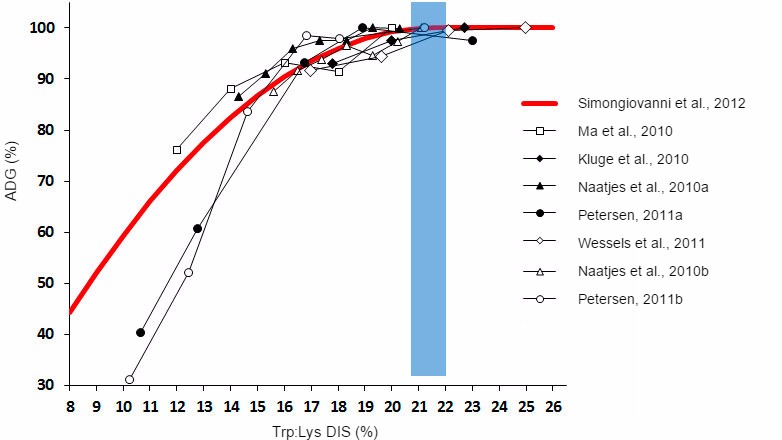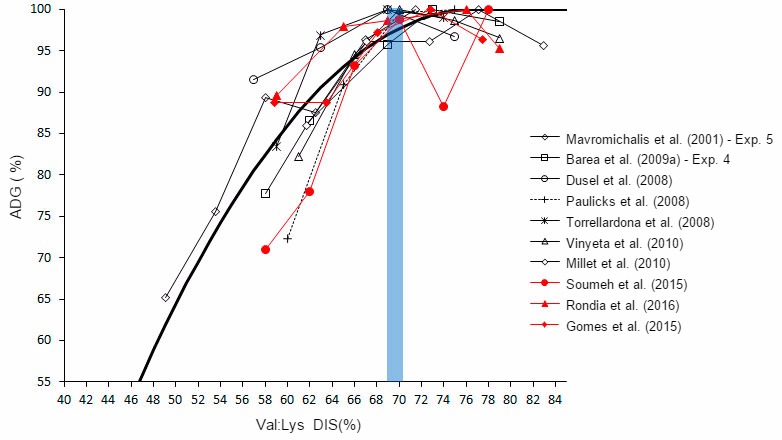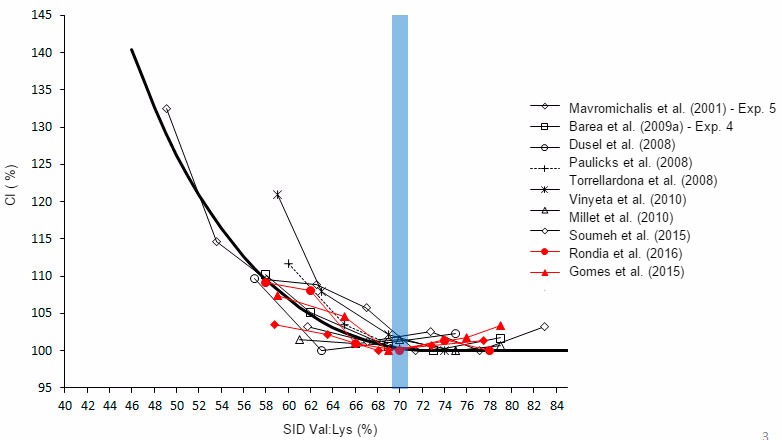Weaning is one of the most critical stages in a piglet's life, during which it will face a series of difficulties that must be overcome: separation from its dam, mixing of litters, environment changes, hierarchy fights, exposure to new pathogens... and also a sudden change in diet, from liquid to solid and with a protein content much higher than that of sow's milk. This change in feeding will pose a major challenge to the piglet's still immature digestive system, especially if the feed has a high protein content. When this happens, the excess protein ferments in the large intestine and causes a dysbiosis and proliferation of pathogenic bacteria, especially E. coli, causing diarrhoea and delayed growth in the piglet. Therefore, the inclusion of highly digestible raw materials, minimization of protein contents and supplementation with amino acids will help prevent pathogens from colonizing the intestine, reducing the risk of diarrhoea, and facilitating the piglets' development and growth.
When reducing protein levels in the feed, however, it is necessary to ensure the animal receives all the amino acids it needs and that a certain balance between the amino acids is maintained, so that neither the growth nor the production rates are affected. Thus, in order to give the piglet exactly what it needs, the concept of ideal protein, defined as the amino acid profile that maximizes nitrogen retention (i.e., muscle) and covers the animal's physiological and growth needs, is applied when formulating diets. The ideal protein profile is kept constant during the growth phase, so that once the Lysine requirements of the animal—which will vary depending on genetics and other reasons— is known, the correct ratios for the rest of amino acids can be applied.

Amino acids are classified as follows: Non-essential amino acids are those that the animal can synthesize; Semi-essential aa are those the animal can synthesize albeit not always in sufficient quantities; and Essential aa are those that the animal can not synthesize (or in insufficient quantities) and therefore have to be provided in the diet. It is important to control essential aa contribution, especially when reducing protein levels.
We know that lysine is the first limiting amino acid for growth in porcine diets, while the rest of essential amino acids are always expressed as a percentage in relation to lysine.
Threonine, the second limiting amino acid, is critical for gut mucin production, thus playing a relevant role in the integrity of the intestinal mucosa. It is also important for the immune system, since it is involved in the synthesis of immunoglobulins. Third, they are limiting for sulphur amino acids (methionine and cystine) and the fourth one is tryptophan. The latter is related to different biological functions, such as the immune response (part of the acute phase proteins), regulates animal behaviour, facilitates the synthesis of proteins and regulates the voluntary intake of feed. Valine, the fifth limiting amino acid, is essential for protein deposition and optimum growth of the animal. Together with isoleucine and leucine, it is considered a branched amino acid, and there are certain interactions between these three amino acids due to the metabolic pathways they share. It is therefore important to know the requirements of all of them well. Figures 1, 2 and 3 show growth regression curves and piglet conversion rate, based on different values of tryptophan / lysine and valine / lysine ratios in the diet, according to scientific studies published by several authors. Likewise, more and more research and studies on the requirements and functions of the rest of essential amino acids (isoleucine, leucine, histidine and phenylalanine) are increasingly being carried out.

Figure 1. Effect of the tryptophan / lysine ratio on piglets growth.

Figure 2. Effect of the valine / lysine ratio on piglets growth.

Figure 3. Response of the valine / lysine ratio on the conversion rate in piglets.
Conclusions
There is a widespread trend throughout Europe to lower the protein level of feed, together with an adequate supplementation of industrial amino acids to ensure that the needs of the animals are covered and that the ideal protein profile is respected. This way, the piglet's growth is maintained and its intestinal health preserved. To date, the availability of industrial amino acids (L-Lys, L-Thr, DL-Met, L-Trp and L-Val) and the increased knowledge of amino acid requirements allow us to go one step further and formulate diets based on essential amino acids, respecting the ideal protein profile and disregarding protein levels.



